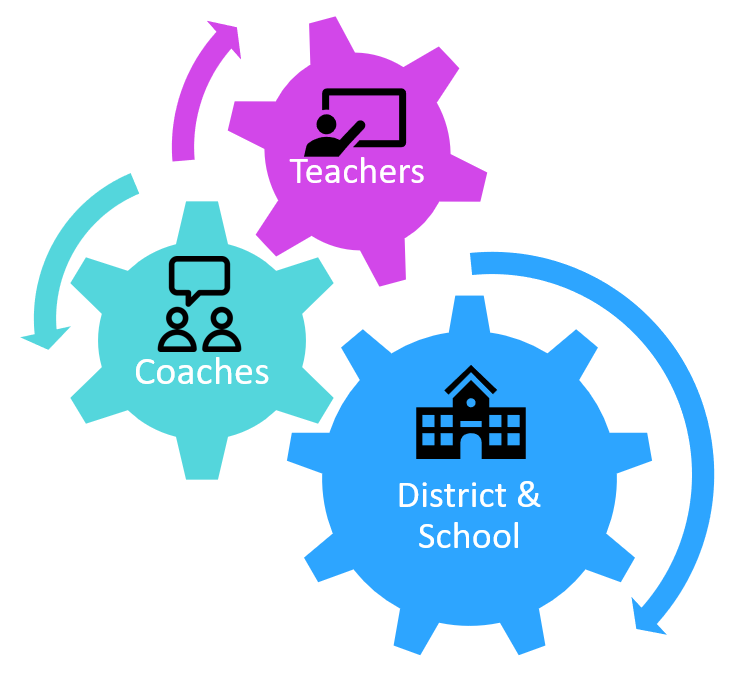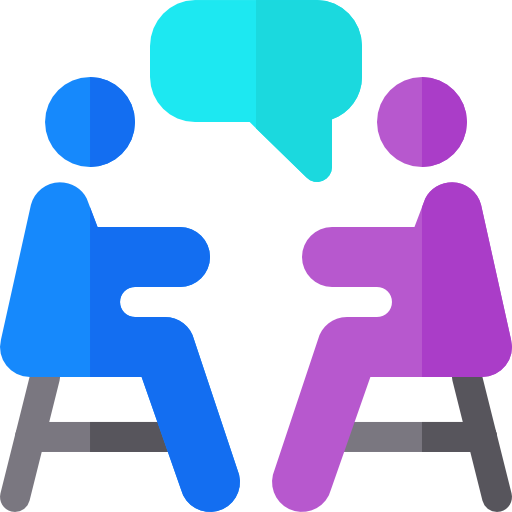My job is to teach elementary computer science and technology classes and when appropriate, help my students’ classroom teachers integrate tech into their classes. Though I am not a technology coach, many of the skills I need to do my job effectively are the same that are required in coaching: building relationships, listening to teacher’s concerns and goals, and understanding how school and district level expectations effect technology and computer science integration at the classroom level.
Developing these skills reflects ISTE Coaching Standard 1: Visionary Leadership 1b and 1d, which we are examining in module 1 of our class “Educational Technology Leadership.” ISTE Coaching 1b focuses on understanding and communicating the district and school-wide vision for technology; ISTE 1d refers to making that vision a reality at the school and classroom level.
Understanding & Supporting the District’s Vision

The district I work in has committed in its strategic plan to offer a Computer Science (CS) curriculum for all students that includes teaching computational thinking, programming, and physical computing. Though CS instruction for K-12 is not yet a state requirement, K-12 state standards exist and are driving districts to develop CS curriculum. Having standards and curriculum but no actual state requirements for teaching them means that coverage and support can be spotty. This makes the roles of CS curriculum developers, technology coaches and tech and CS specialists crucial for communicating the importance of integrating computer science concepts and skills into classroom-level instruction.
Communicating a district-based vision of CS integration is important because:
- It is more likely to have the support of school administrators
- Messaging and focus will be consistent between any district-based CS professional development and informal school-level training or discussions
- It signals to teachers that it is a district-wide priority and will therefore at some point become a priority for them (particularly once CS becomes a state requirement)
The Importance of a Local Focus

It behooves schools to have staff available to guide them through this shift. Successful transformation requires intimate understanding of the school and its culture, as well as the curriculum and prevailing instructional philosophies.
Gura, 2018, p. 44
No amount of top-down messaging about computer science integration will succeed if it isn’t respectfully conveyed and accompanied by school-level support. I have yet to meet a teacher who doesn’t recognize the importance of building students’ technology or computer science skills. They just may not have the time or the experience with the subject matter to teach it. In most cases, it falls upon the technology or CS specialist or the technology coach. That works fine for now as a once-a-week class or an occasional project but will not be enough once CS becomes a state requirement.
So how can coaches and specialists help teachers learn how to integrate CS into their classrooms so that they are more prepared when it does become a requirement?
- By building strong relationships with teachers
- By acting as a conduit to spread ideas and best practices
- By helping to personalize CS integration for each teacher’s curriculum, comfort-level and group of students
Strong Relationships & Mutual Learning

It is harder to help someone you don’t know well. Several of the sources I used to prepare from this module stress that relationships are fundamental to successful coaching. Foltos (2013) describes taking the time to build a friendly, trusting relationship that is respectful of a teacher’s privacy, time, and agency (i.e., support teachers in the work but don’t do it for them). In the Dynamic Learning Project, a study of technology coaching led by Digital Promise, two of the key qualities cited for effective coaching were relationship building and strong communication.
As a new teacher, I truly appreciate learning from the veteran teachers I work with, but it is good to know that even experienced coaches continue to value this aspect of their job. As Foltos (2013) describes, this mutual learning is a way to show respect for each other, and that for experienced coaches, “Learning with and from their peers is a major part of what they love about coaching and why they continue to coach” (pp. 9-10).
The Coach as a Conduit

…Share and praise examples of school community members who take risks, attempt out-of-the-box activities with students, and have noteworthy successes. Such sharing acknowledges these individuals, encourages others, and disseminates ideas and information
Gura, 2018, p. 46
My background in business has made me notice how generous educators are in sharing their ideas compared to many corporate environments. That generosity often goes untapped, however, as best practices are siloed within classrooms or schools, simply because the people or mechanisms aren’t there to enable the transfer of ideas. Coaches, tech and CS specialists can be in a unique position to take what they learn from the teachers they work with and share it with others both within their school and district.
In the Dynamic Learning Project, researchers saw multiple instances of coaching leading to the spread of ideas. An example was given of a 7th grade teacher who collaborated with a coach to design an escape room activity. After seeing its success, the lesson was adopted by the rest of the 7th grade and 6th grade teams (Bakhshaei, Hardy, Francisco, Noakes, & Fusco, 2018, p. 21).
Personalized Coaching and Integration

A close relationship between a coach and a teacher should lead to the use of technology in the classroom that enhances learning and reflects the teacher’s and students’ unique styles and needs.
An example of CS integration in my own district was to use Scratch Jr. in a Kindergarten class for what used to be a traditional animal report. Students drew their animal, took a picture of it and added it as a sprite in Scratch Jr., chose a background that reflected the animal’s habitat, then used speech bubbles or voice recording to convey several facts about the animal. If students were finished with the basics, they could add animation (many did). The teacher embraced and owned the project, the students were completely engaged (squealing with delight), and the artifacts were personalized and displayed an understanding of sequencing. To me, this was the ideal integration of CS into a traditional lesson and one I hope to emulate at my own school.
Another example of meaningful integration of technology into non-tech classes is shown in the Edutopia video in Figure 1. It describes the work of a Pennsylvania high school technology coach who helps teachers in the ways that show a deep understanding of teaching goals and students’ needs.
It is my goal (and my delight) to build a relationship with each of the teachers I work with. I hope to learn from them so that the computer science topics I cover in my classes pertain to what students are learning throughout their school day. I also hope to work with these teachers to bring computer science and technology tools into their classrooms to support and extend what is being taught.
References
Bakhshaei, M., Hardy, A., Francisco, A., Noakes, S. & Fusco, J. (2018). Fostering powerful use of technology through instructional coaching – Results from the pilot year of the Dynamic Learning Project. Digital Promise.org.
http://digitalpromise.org/wp-content/uploads/2018/08/DLP_CoachingReport_2018.pdf
Cator, K., & Francisco, A. (2018). Fostering powerful use of technology through instructional coaching. Digital Promise.org. https://digitalpromise.org/2018/08/13/fostering-powerful-use-of-technology-through-instructional-coaching/
Foltos, L. (2013). Peer Coaching. Thousand Oaks, CA: Corwin.
Gura, M. (2018). “The Digital Change Agent,” Chapter 4, pp 43-52 in The Edtech Advocate’s Guide to Leading Change in Schools. International Society for Technology in Education. Portland, OR.
Instructional coaching driving meaningful tech integration (2015). Edutopia. https://www.edutopia.org/video/instructional-coaching-driving-meaningful-tech-integration
Bridget-I am excited for your new role this school year and know you will do amazing with integrating computer science within the schools. I enjoyed reading more about the role you have and how similar it is to a digital coach. I agree on how important building a strong and trusting relationship can be to a successful coaching experience. I also think it is essential to personalize each coaching experience in order to meet the teachers needs. Each teacher may have a different idea of where they need to grow and may produce different plans to get there. Thank you for sharing your resources and presenting a well organized blog post!
Wow, what a powerful post, Bridget. You are spot on with needing coaches to help with the transition and so eventually, teachers will know how to incorporate these CS skills versus only in a stand alone class. Also, how you note the importance of collaboration being key and how this grows and spreads ideas while also giving teachers the ability to enhance their teaching skills. I wish that district leaders and administrators would read this post – seriously – it is really compelling, clear, concise and well thought out with the research to back up your ideas. Your school is lucky to have you on the frontlines of integrating CS education into the classroom.
Bridget, your teachers are so lucky to have you. You work so hard to work CS into teachers and students learning in meaningful ways. I wish we had you at our school. I feel like a tech. coach would be so helpful. We have an awesome coach but he is focused on district led goals with our math. I think a technology coach has the ability to really impact all learning contents. I can’t wait to see what you learn this year!
Thoughtful approach to coaching in a subject that many teachers might find intimidating. Your emphasis on personalizing your collaboration with learning partners feels so powerful. I also like the emphasis in the video on identifying instructional goals and student competencies as one of the first steps in coaching. Really looking forward to learning more about how these approaches affect your coaching work this term.